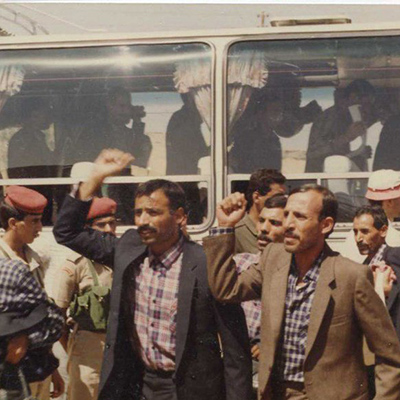Terms & Concepts
Exchanging Prisoners of War
Sajjad Naderipour
157 Views
During the eight years of the Iran–Iraq War, 40214 Iranians were taken prisoner of war (POW) by the enemy, while Iran captured 68245 Iraqi forces.
Between 1981 and 2004, prisoners of war on both sides were exchanged in 140 stages, across three time periods. From June 16, 1981, to March 16, 2004, Iranian combatants who had been taken captive were brought back to the country through 78 stages. During this period, 574 individuals died or were martyred, and 500 sought asylum.[1]
Meanwhile, a number of the 68245 Iraqi POWs held in Iran were repatriated in 120 stages. Among them, 10336 Iraqis sought asylum and were granted citizenship by the Islamic Republic of Iran. Moreover, 1214 of the POWs died, and their bodies were returned to their country.[2]
The prisoner exchanges between Iran and Iraq occurred in three phases. In the first one, nearly half of the Iranian POWs released by Iraq were civilians captured in the early days of the war in southern border villages. Also, some of them had been kidnapped by opposition groups such as Komala and the Democratic Party in Kurdistan and then handed over to the Iraqis. Among the released prisoners in this phase were 23 civilian women mostly living in border areas including 5 medical workers. Some injured and disabled individuals were also released in this phase. The POWs were handed over to Iranian authorities under the supervision of representatives of the International Committee of the Red Cross at Mehrabad Airport, Ankara Airport in Turkey, Larnaca Airport in Cyprus, and the Khosravi–Munzariyeh border crossing.[3]
The second phase commenced following the Islamic Republic of Iran’s acceptance of United Nations Security Council Resolution 598 on July 18, 1988, and subsequently by Iraq on August 6, 1988, marking the end of the war. Before the ceasefire was officially implemented, a three-member UN delegation visited Iran and Iraq between July 24 and August 4, 1988, to assess the situation of the POWs’ return and exchange. In their report, they emphasized that the repatriation process could take place with goodwill shown by both sides, consultation with the UN Secretary-General, and coordination with the International Committee of the Red Cross. Addressing the Security Council the UN Secretary-General said that Article 3 of the resolution called for the immediate release and repatriation of POWs following the cessation of active hostilities. However, the returning Iranian and Iraqi POWs did not proceed as envisioned by the resolution. Instead, it got caught up in a confusing and unclear process, mostly because the resolution was weak and the situation was stuck between war and peace. As a result of Iraq’s obstruction in implementing the resolution, peace negotiations stalled, and the release and exchange of POWs were delayed. Eventually, after a series of letters exchanged between Saddam Hussain and Hojatoleslam Akbar Hashemi Rafsanjani (then President of Iran), the two sides reached an agreement in August 1990 to implement Resolution 598 and withdraw to the internationally recognized borders stipulated in the 1975 Algiers Agreement on borders and good neighborly relations. Following this agreement, the exchange of prisoners resumed.[4]
In the second phase of the prisoner exchange, the captives were handed over to Iranian authorities at the Khosravi–Munzariyeh border crossing and Mehrabad Airport. This exchange took place in 42 stages the first of which happened on August 17, 1990, at the Khosravi–Munzariyeh border, involving 1272 individuals, who were transferred to Iran by representatives of the Red Cross.[5]
In the third phase of the exchange, which lasted from 1990 to 2003, the Iraqi officials handed over a total of 639 POWs to Iranian authorities in 17 stages under the supervision of Red Cross representatives. That was the end of this phrase and the case of the remaining Iranian and Iraqi POWs was closed. Thus, the International Committee of the Red Cross, along with Iraqi officials and representatives of the Islamic Republic of Iran, confirmed that there were no longer any living POWs from either side held in the two countries.[6]
Major General Hussain Lashgari (martyred), a pilot in the Islamic Republic of Iran Army Air Force, was the last POW to return to the country.[7]
The details of exchanging POWs from 1981 to 2003 are as follows:
- 1981: 62 individuals in two stages; location: Larnaca Airport (Cyprus) – Mehrabad Airport (Tehran)
- 1983: 32 individuals in one stage; location: Ankara Airport (Turkey)
- 1984: 99 individuals in two stages; location: Ankara Airport (Turkey) – Mehrabad Airport (Tehran)
- 1985: 294 individuals in four stages; location: Ankara Airport (Turkey) – Mehrabad Airport (Tehran)
- 1986: 76 individuals in one stage; location: Mehrabad Airport (Tehran)
- 1987: 129 individuals in two stages; location: Mehrabad Airport (Tehran)
- 1988: 485 individuals in eight stages; location: Mehrabad Airport (Tehran)
- 1989: 165 individuals in three stages; location: Mehrabad Airport (Tehran)
- 1990: 41205 individuals in 58 stages; location: Mehrabad Airport (Tehran) – Khosravi–Munzariyeh border
- 1991: 421 individuals in one stage; location: Khosravi–Munzariyeh border
- 1993: 103 individuals in two stages; location: Khosravi–Munzariyeh border
- 1994: 1 individual in one stage; location: Khosravi–Munzariyeh border
- 1995: 100 individuals in one stage; location: Khosravi–Munzariyeh border
- 1996: 871 individuals in two stages; location: Khosravi–Munzariyeh border
- 1997: 542 individuals in two stages; location: Khosravi–Munzariyeh border
- 1998: 6248 individuals in eleven stages; location: Khosravi–Munzariyeh border
- 1999: 276 individuals in two stages; location: Khosravi–Munzariyeh border
- 2000: 4118 individuals in ten stages; location: Khosravi–Munzariyeh border
- 2001: 507 individuals in two stages; location: Khosravi–Munzariyeh border
- 2002: 902 individuals in four stages; location: Khosravi–Munzariyeh border
- 2003: 59 individuals in one stage; location: Khosravi–Munzariyeh border
According to the available documents, Saddam Hussain many times falsely claimed to have released and handed over some Iranian POWs to the Red Cross in an attempt to present himself as a peace-seeking figure to the international community.[8]
[1] Alamaty, Gholamreza, Vakavi va Tahlil-e Chegounegi-ye Tabadol-e Usara-ye Jang-e Iran va Araq (1979–1988) (Exploring and Analyzing the Exchange of Iran-Iraq War Prisoners), Faslname-ye Elmi-ye Motaleat-e Defa Muqaddas, Vol. 7, No. 2, Summer 1400, p. 235.
[2] Ibid., p. 241.
[3] Ibid., p. 236.
[4] Ibid., Pp. 234, 235.
[5] Ibid., Pp. 238–239.
[6] Ibid., p. 241.
[7] Avalin va Akharin Asir-e Iran (The First and Last Iranian POW), Fars News, Code: 14020503000738; Zendegi-ye Hussain va Monireh ba Sabouri va Esalat Mana Peyda Kard (Hussein and Monireh’s Life Gained Meaning Through Patience and Nobility), Roozname-ye Javan, 1401, Year 24, No. 6562, p. 2.
[8] Faslname-ye Elmi-ye Motaleat-e Defa Muqaddas, No. 235, Summer 1400, p. 244; Khorrami, Muhammadali, Jang-e Iran va Araq dar Asnad-e Sazman-e Mellal (The Iran-Iraq War in United Nations Documents), Vol. 4, Tehran, Markaz-e Motaleat va Tahqiqat-e Jang-e Sepah-e Pasdaran-e Enqelab-e Eslami, 1387, Pp. 229–230.





